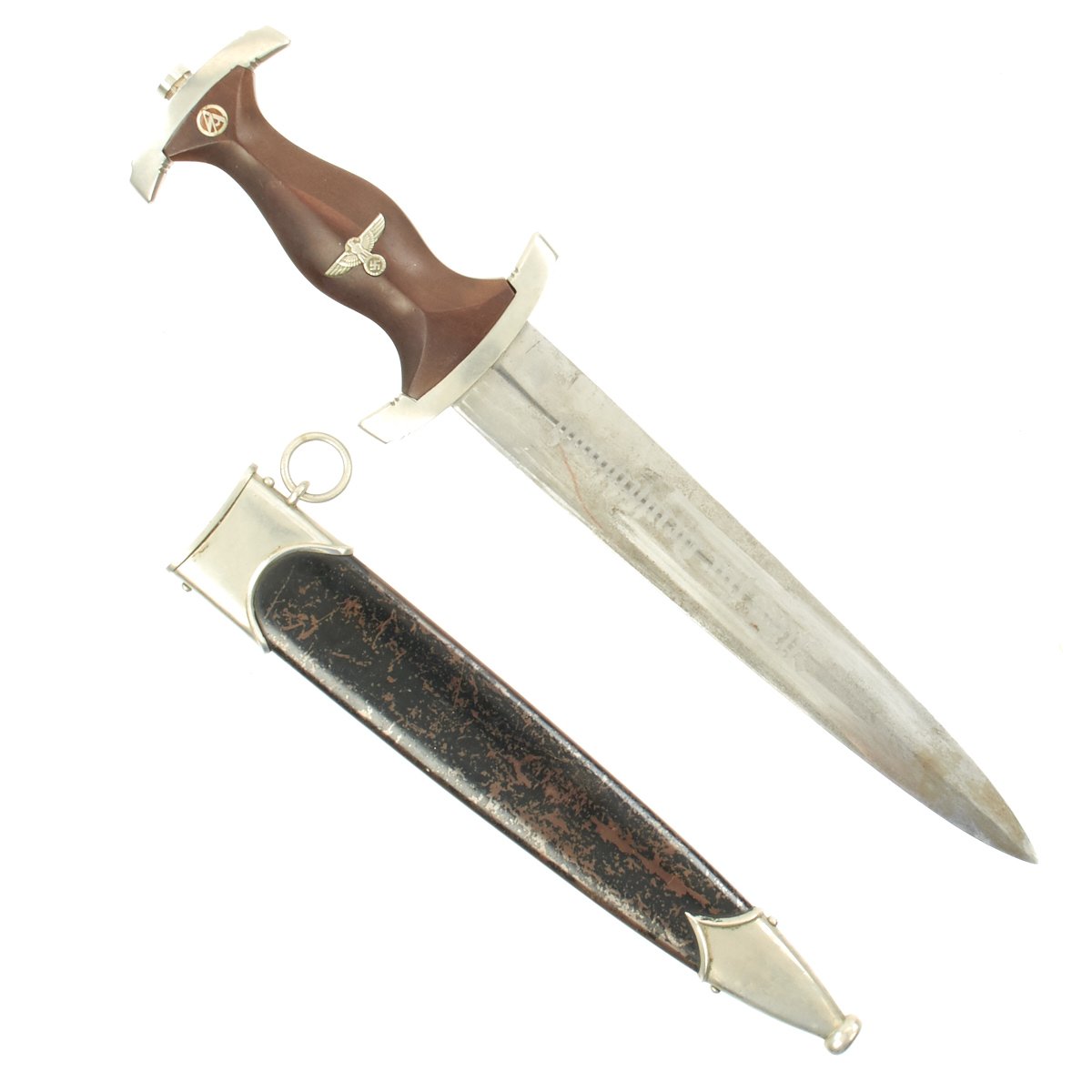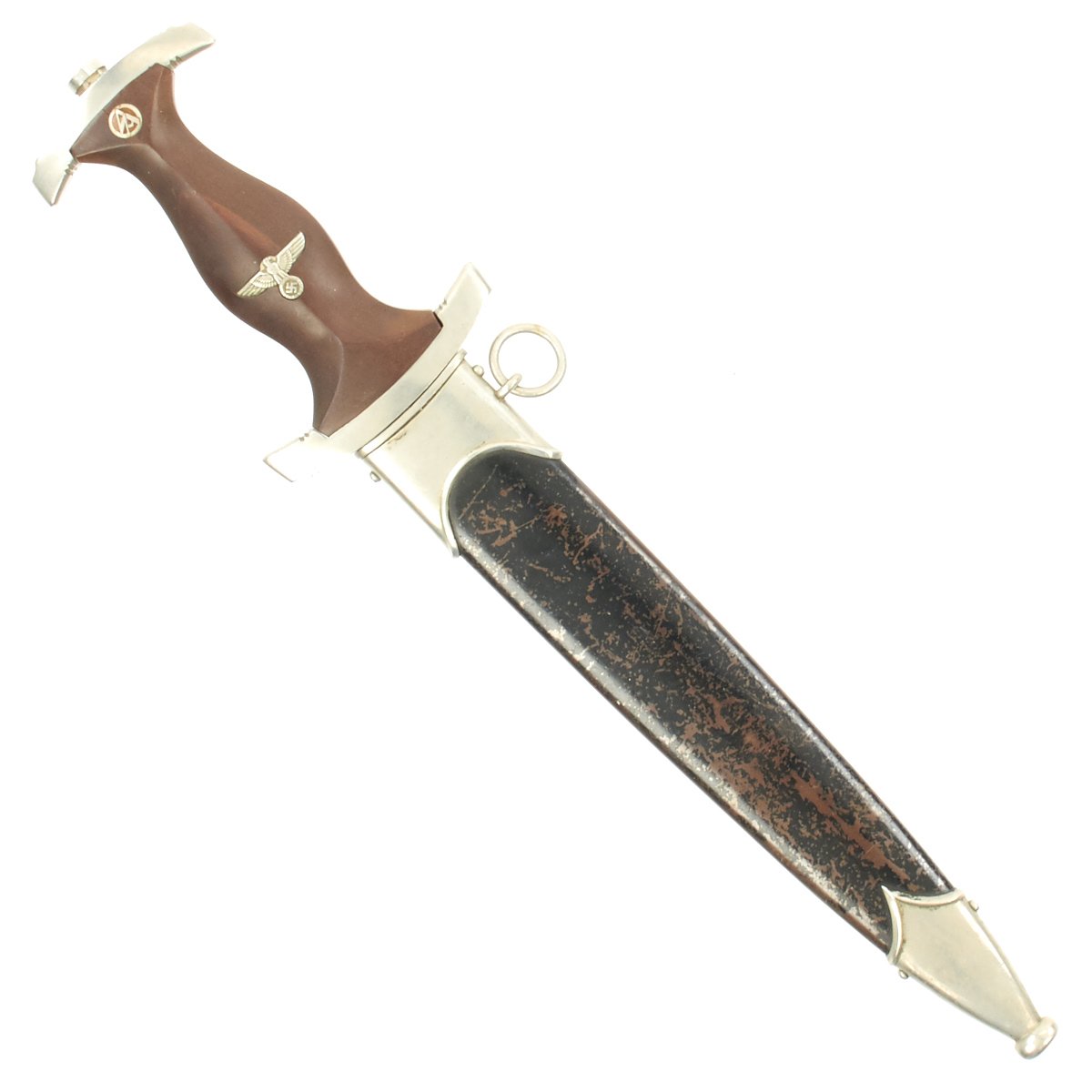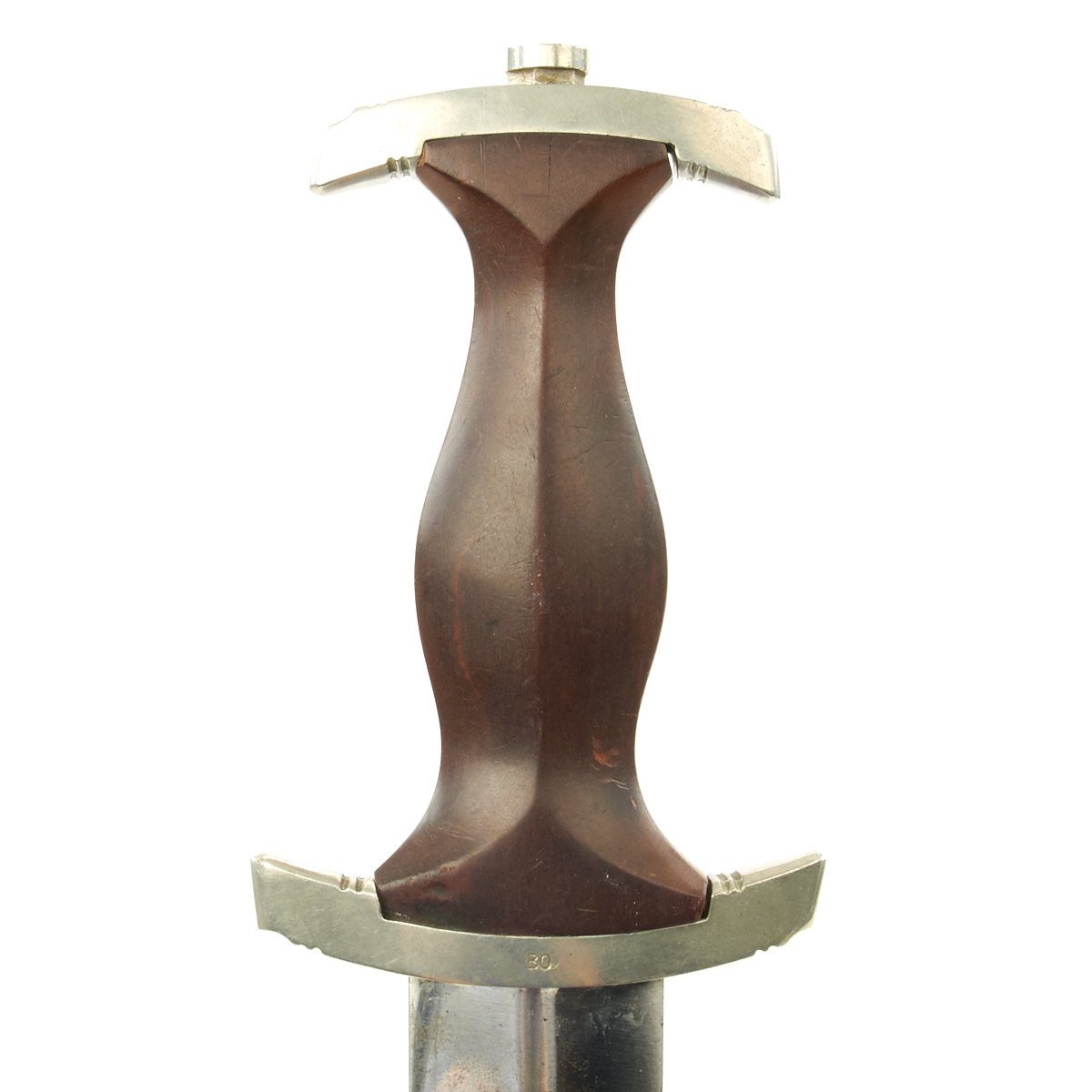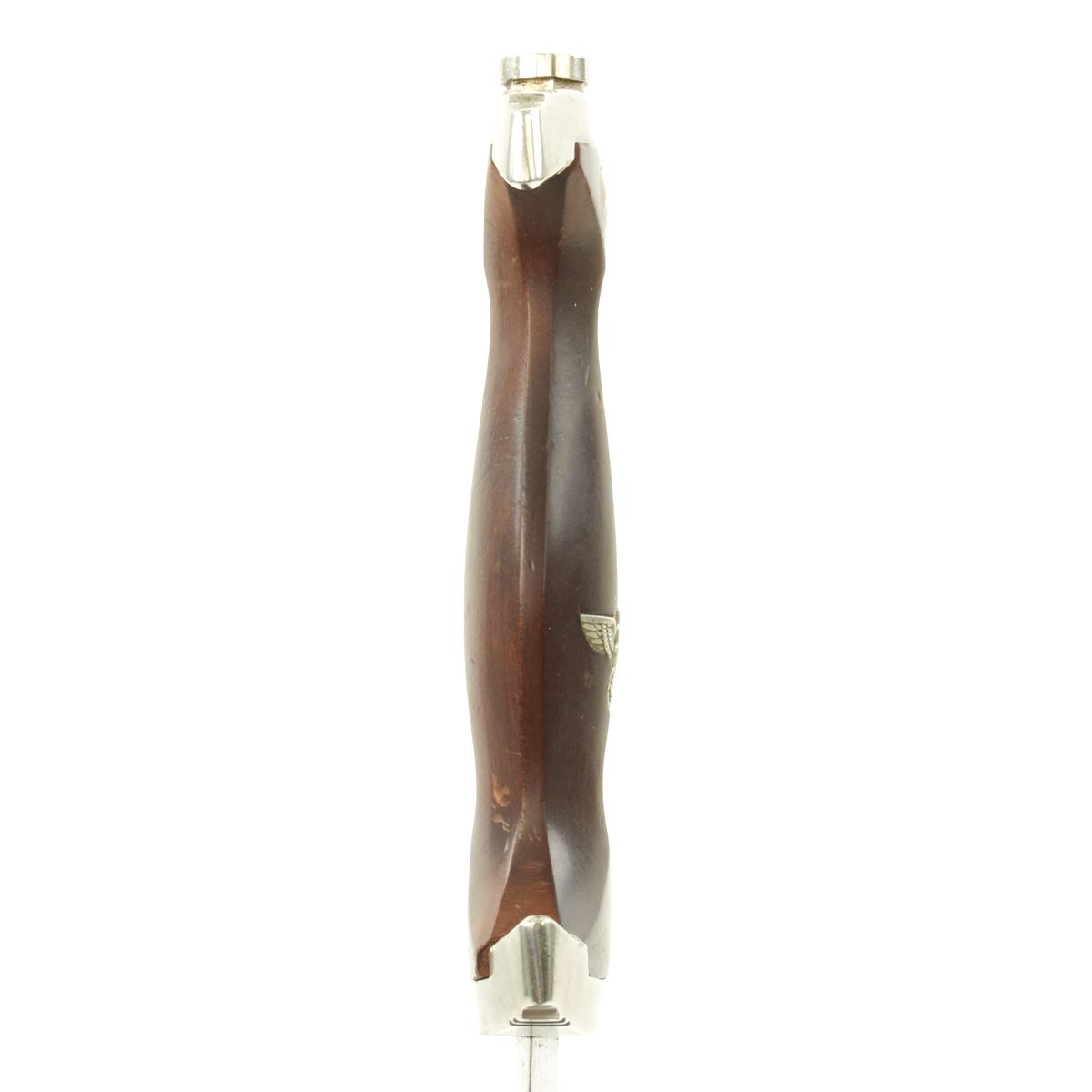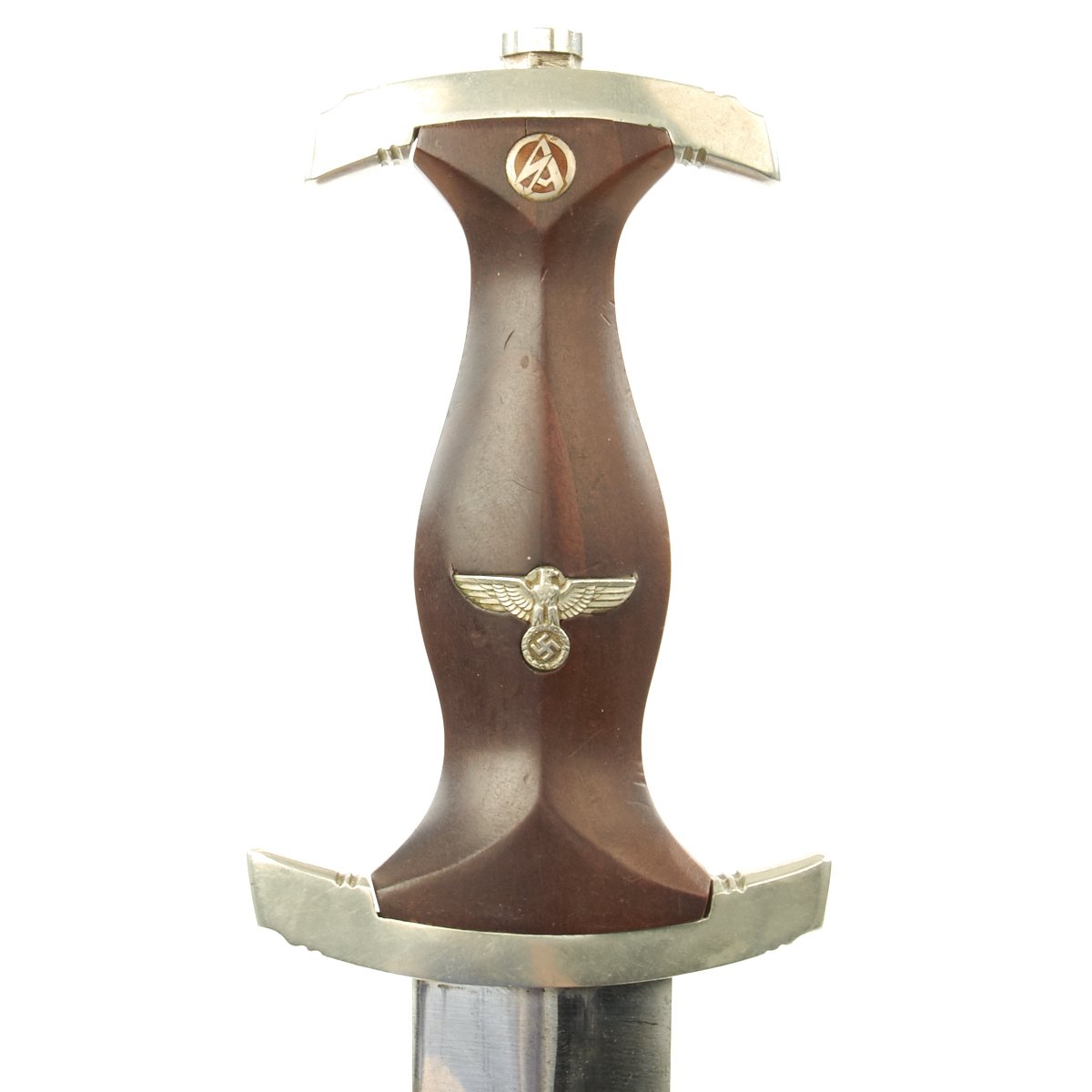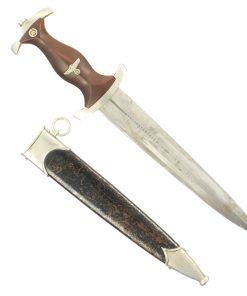Original German Early WWII SA changed to NSKK Dagger by Gebrüder Bell of Solingen-Gräfrath Original Items
$ 895,00 $ 223,75
Original Item: Only One Available. This is a very nice early pattern Sturmabteilung (Storm Division – SA) Dagger, made by firm of Gebrüder Bell, Stahlwarenfabrik, in the legendary blade-making city of Solingen, Germany. The dagger comes comes compete with the original scabbard, which is in great shape, but was also painted black after production. This would indicate that the dagger was produced pre-1934, when the Nationalsozialistisches Kraftfahrkorps (National Socialist Motor Corps – NSKK) was still part of the SA.
After being made an official NSDAP organization, the NSKK changed the specification for their daggers to have a brown handle with a black scabbard, to differentiate them from the SA. Members who already had daggers would paint them black to conform with the new standard, so this is definitely an interesting piece of history from a turbulent time in Pre-WWII Germany.
The dagger has solid nickel silver fittings throughout, and is an excellent example. The crossguards and tang nut are in very good condition throughout with all fittings having a nice lightly aged patina. There is a little age to these mounts but there is no lifting anywhere, showing that they are solid and not plated.
The lower reverse guard is Gruppe/Gau marked BO, for Bayerische Ostmark (Bavarian Eastern March). This was an administrative division of NSDAP Germany in Lower Bavaria, Upper Palatinate and Upper Franconia, Bavaria, which had previously been a NSDAP Party region.
The grip is a fine product having a nice red brown color, with having medium center ridge construction. This grip is in good condition and fits the crossguards nicely, thought it has shrunk a bit. There is also a crack near the pommel on the emblem side. The symbol button is nicely set, and still has all of the enamel intact, with a bit of oxidation. The grip eagle is a fine example being the style with beak that points straight, with nice plating. The details are still there to the eagle to include the beak, breast feathering, wing feathering, talons, wreath and mobile swas.
The scabbard shell is straight throughout and is the early-war style, with a brown “anodized” finish on the steel, which was then lacquered. This was then stripped, and painted with black enamel per NSKK guidelines, however the original brown anodized finish was left intact. As the enamel flaked off, the original brown finish can now be seen, especially on the back of the scabbard.
The upper and lower fittings are solid nickel silver, and have a nice patina, with some dents and scratches showing typical wear. The bottom fitting is dented in typical of the softer alloy. The throat nicely matches the crossguards and the screws for the top and bottom mounts are still present.
The blade of this example is marked GEBR. BELL over SOLINGEN-GR in an oval border around their trademark “GB” monogram. This is a mark used by Gebrüder Bell, Stahlwarenfabrik, a steelware firm located in the Gräfrath borough of Solingen, the legendary “City of Blades” in western Germany. This company was founded in 1876, and was owned by members of the Bell family. During the WWII Period it was owned by Ernst, Arthur, and Paul Bell.
The blade is is in very good condition, with runner marks as well as some staining and light oxidation in places. The original factory cross grain can still be seen throughout the blade, and it does not appear to have been sharpened after the factory. The acid-etched Alles für Deutschland (Everything for Germany) SA motto is crisp, though the factory darkening has unfortunately mostly worn off from cleaning.
A nice early SA dagger with original scabbard, converted for use with the NSKK. Ready to display!
History of the SA / NSKK-
The SA or Brown Shirts, were a private political formation which Adolf AH and the NSDAP used to maintain order at organized Party meetings and demonstrations. The group was formed in 1921, and grew to a huge force of nearly 3,000,000 men by the later 1930’s. To instill esprit de corps, as well as create employment for the Blade City of Solingen, it was decided each SA man would carry a dagger with his Brown Shirt uniform. Huge quantities needed to be produced to accommodate the demand. The dagger initially was produced of hand-fitted nickel mounts with attractive finished wood grip and brown anodized (a bluing process) finished scabbard.
The blade was etched with the SA motto, Alles für Deutschland. Examples produced prior to 1935 were stamped with the German sector of the SA group on reverse lower crossguard. Later examples underwent standardization through the RZM ministry. These pieces were produced of cheaper plated zinc-base fittings and scabbards were simply painted brown.
The National Socialist Motor Corps (NSKK) was a successor organization to the older National Socialist Automobile Corps (NSAK), which had existed since being formed on 1 April 1930. Legends about the actual emergence of the NSKK go back as far as 1922, when the publisher of the Völkischer Beobachter (People’s Observer) and founding member of the German Workers’ Party (DAP), Dietrich Eckart, allegedly purchased trucks so the SA could perform their missions and transport propaganda materials.[3] Martin Bormann founded the NSAK, which itself was the successor to the SA Motor Squadrons (Kraftfahrstaffeln). AH made the NSAK an official NSDAP organization on 1 April 1930. The NSAK was responsible for co-ordinating the use of donated motor vehicles belonging to party members, and later expanded to training members in automotive skills. Adolf Hühnlein was appointed Korpsführer (Corps Leader) of the NSAK, which was to serve primarily as a motorized corps of the Sturmabteilung (SA). Hühnlein became the organization’s “nucleus”.
The organization’s name was changed to the National Socialist Motor Corps (Nationalsozialistisches Kraftfahrkorps; NSKK), becoming official on 1 May 1931. It was essentially a paramilitary organization with its own system of paramilitary ranks and the smallest of the NSDAP organizations. Despite its relatively smaller size, when the NSDAPs celebrated Braunschweiger SA-day on 18 October 1931, the NSKK had upwards of 5,000 vehicles at its disposal to move men and materials.
The primary aim of the NSKK was to educate its members in motoring skills or what was called “fitness in motoring skills” (motorische Ertüchtigung),[8] but it also transported NSDAP and SA officials. In the mid-1930s, the NSKK also served as a roadside assistance group, comparable to the modern-day American Automobile Association or the British Automobile Association.
On 20 July 1934, three weeks after the major purge the SA suffered during the Night of the Long Knives, the NSKK was separated and promoted into an independent NSDAP organization.[10] From 1935 onward, the NSKK also provided training for Panzer crews and drivers of the Heer (German Army). The NSKK had two sub-branches within the organization known as the Motor-HJ (Motor-jugend; Motor-HJ) and Naval NSKK (Marine-NSKK). The Motor-HJ branch was formed by Reichsjugendführer (HJ Leader) Baldur von Schirach after he became a member of the NSKK. It operated 350 of its own vehicles for educational and training purposes. The Naval NSKK trained men in the operation and maintenance of boats.
Fast Shipping with Professional Packaging
Thanks to our longstanding association with UPS FedEx DHL, and other major international carriers, we are able to provide a range of shipping options. Our warehouse staff is expertly trained and will wrap your products according to our exact and precise specifications. Prior to shipping, your goods will be thoroughly examined and securely secured. We ship to thousands clients each day across multiple countries. This shows how we're dedicated to be the largest retailer on the internet. Warehouses and distribution centres can be located throughout Europe as well as the USA.
Note: Orders with more than one item will be assigned a processing date depending on the item.
Before shipping before shipping, we'll conduct a thorough inspection of the items you have ordered. Today, the majority of orders will be delivered within 48 hours. The delivery time will be between 3-7 days.
Returns
The stock is dynamic and we cannot completely manage it because multiple stakeholders are involved, including our factory and warehouse. So the actual stock may alter at any time. It's possible that you may not receive your order once the order has been made.
Our policy is valid for a period of 30 days. If you don't receive the product within 30 days, we are not able to issue a refund or an exchange.
You can only return an item if it is unused and in the same state as the day you received it. You must have the item in its original packaging.
Related products
Uncategorized
Uncategorized
Uncategorized
Uncategorized
Australian WWII Owen MK1 Machine Carbine SMG Custom Fabricated Replica with Sling Original Items
Uncategorized
Uncategorized
Uncategorized
Uncategorized
Uncategorized
Uncategorized
Uncategorized
Uncategorized
Uncategorized
Uncategorized
Angolan Rebel 1970s era 60mm Inert Display Mortar from Angolan Civil War Original Items
Uncategorized
Uncategorized
Uncategorized
Uncategorized
